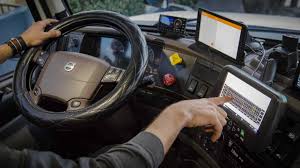Federal law governs the FMCSA ELD mandate. It states that the rule requires electronic logging devices to be used by commercial motor vehicle operators. Some CMV drivers are exempt. However, the majority must adhere to FMCSA regulations. Along with the U.S. Department of Transportation, and the FMCSA (DoT). Their main objective is to increase traffic safety and lessen accidents in the US. The major goals of the ELD mandate are to protect commercial drivers, lessen driver weariness, enforce the Hours of Service regulations, and prevent traffic accidents.
Truck drivers and carriers are using electronic logging devices (ELDs) more frequently to track activities, and the federal government’s relatively recent ELD regulation has made this the new industry standard. The ELD mandate surely has a significant influence because trucking is one of the most prevalent professions in the U.S. We’ve put together a guide to help you learn the specifics of how this mandate operates, who it affects, and what you need to do to comply.
ELD Mandate Hos
The term “HOS” refers to the maximum amount of time that drivers may be both driving and on duty. Currently, HOS requirements for drivers who transport property require a minimum of 10 hours of off-duty time, including at least seven straight hours spent in a sleeper berth. This includes a minimum 30-minute break after eight straight hours of driving. The number of hours that drivers can drive in a single day and over the course of a week is also capped. The FMCSA publishes an overview of HOS laws along with a more thorough Interstate Truck Driver’s Handbook to Hours of Service.
Eld Mandate Hour of Service Information
An ELD, also referred to as an electronic logbook, keeps track of the location, movement of the vehicle, and kilometers are driven. ELDs are frequently small, GPS-like gadgets, though they can also be certified smartphones and other wireless devices. When it has been collected, the data is difficult to update because of security measures that prevent both drivers and managers from making changes on their own. The ELD is intended to make it simple for information to be transferred to safety officials during roadside inspections, safety audits, and investigations. If an ELD is inspected, inspectors look at the “data frame” to look for any hours-of-service (HOS) infractions.
The U.S. federal government policy known as the ELD HOS mandate mandates that drivers of commercial motor vehicles subject to this law use electronic logging devices. ELDs, fitted to a commercial motor vehicle engine record driving hours, and automatically log a driver’s hours of service (HOS). Their driving hours, as well as the vehicle’s engine, motion, and mileage. The electronic logging device (ELD) rule, which Congress imposed as a component of MAP-21, is meant to make it simpler and quicker to accurately collect, manage and communicate records of duty status (RODS) data.
ELD Mandate Exemption
The ELD mandate applies to drivers and operators who previously used paper log books for commercial driving activities that are required to maintain hours of service records.
Who is exempted from the ELD?
Certain drivers and vehicle categories are excluded from the law and they are:
- The use of timecards is still permitted for drivers who operate within a 100-air-mile radius.
- Freight drivers without a CDL (commercial driver’s license) who travel within 150 air miles are known as “drive-away, tow-away” drivers.
- Vehicles produced prior to the model year 2000.
Who is covered by the ELD mandate?
- Now, drivers of inter-state commercial motor vehicles must maintain RODS (record of duty status)
- Automobiles weighing greater than 10,000 pounds
- Vehicles carrying hazardous loads with placards
- Vehicles with more than eight or fifteen occupants (depending on vehicle class)
What data is Recorded by an ELD?
The following information is automatically recorded by the ELD to maintain records of duty status, assist drivers in monitoring their driving limitations, and avoid problems caused by fatigue:
- Date
- Time
- Location
- Engine time
- Miles of a vehicle
- Driver’s license
- User identification
- Vehicle
- Motor holder
Characteristics and operations of ELD equipment
- Synchronization on an internal level with the engine control module
- Record driving time and information automatically
- Records place
- Telematic (wireless or email) or local data transfer (USB 2.0 or Bluetooth)
- Deters tampering
- Record certification for drivers (at end of each 24-hour period)
- Reports on demand to safety officials user guide
- Sound controls (volume and mute)
Real-time driver tracking is possible with ELDs. They provide fleets with planning, scheduling, ELD compliance, vehicle inspections, and general fleet management. Following the FMCSA’s adoption of the ELD mandate, ELDs are now required for non-exempt commercial drivers. The majority of the time, electronic logging devices are linked to a fleet management system, a mobile app for drivers, and a CMV (commercial motor vehicle). The Hours of Service data for the driver is then captured by the device and sent to the mobile app for viewing.
ELD Mandate Reviews
Users who have used the software in the past or present have posted reviews describing their impressions, advantages, and disadvantages. They assist in giving you information on what to anticipate when utilizing the software!
Pros: The main goal of software for electronic logging devices is to increase productivity and safety in the commercial trucking sector. It accomplishes this by making sure that drivers follow HOS rules, which can lower the possibility of accidents brought on by driver weariness. The platform also gives carriers precise information on driver availability, fuel use, and route planning, allowing them to streamline their operations. Ultimately, ELD software utilization benefits both drivers and carriers since it encourages efficiency, compliance, and safety.
Cons: Some ELD software customers have experienced issues with installation and integration with their current systems, which can result in service outages. Some drivers have also expressed worries about the security of their data and the potential use of ELDs for surveillance or disciplinary actions.
ELD Mandate Plus
With the press of a button, you can maintain full DOT and FMCSA compliance with the help of the ELDMandate Plus which is an Electronic log book. Motor carriers can employ ELDs and related support systems as their principal method of collecting HOS information. Also, guarantees of HOS compliance thanks to the ELD Mandate Plus’s architecture, which makes it possible for drivers and motor carriers to comply with HOS rules effectively. Integral synchronization will be used to communicate engine information to the ELD.
The ELD will be resistant to tampering, preventing unauthorized modification of the recorded data. ELDs that have been certified by the providers will meet or surpass the performance standards. It will be possible to transfer standardized ELD data to accredited safety experts.
Is an ELD Mandatory?
It is a federal law that is subject to the same enforcement as other federal laws (issued by the FMCSA and executed by the DOT and other law enforcement).
ELDs and HOS compliance were implemented to prioritize driver health and safety and to make sure that carriers aren’t overworking their staff. Regardless of the scale of operations, the trucking industry cannot disregard safety. Regulations like HOS were created as a result of too many accounts of driver weariness and fatal accidents. The most crucial aspect of every business is adjusting to governmental requirements that safeguard the health and safety of its workers and the general public on the road.
A driver can easily and quickly enter correct and timely data by integrating an ELD solution. For convenient information gathering, the data is automatically captured and delivered to a fleet manager’s tablet or desktop. Also, an ELD system can make it simple to recognize the most cautious drivers by assessing their performance and providing incentives for better driving.
What Is ELD, and How Does it Work?
In the truck cab, a tablet computer is used as an electronic logging device (ELD). It keeps track of information on how the car is being driven as well as their hours of service (HOS) and record of duty status (RODS). According to the Federal Motor Carrier Safety Administration (FMCSA) in the United States, ELD use will be required for the majority of commercial vehicles starting on December 18, 2017, and for all vehicles covered by this law by December 16, 2019.
Who Is Exempted From the ELD Mandate In Canada?
All Canadian commercial motor vehicle (CMV) fleets must have certified ELD devices in place by January 1, 2023, per the new electronic logging device (ELD) legislation. Before this mandate, there were no explicit guidelines established by the Canadian government for the use of ELDs to track truck drivers’ hours of service (HOS). Due to this, it may be unclear who is excluded from this rule and what modifications or requirements are connected to it.
There are now four commercial vehicle exclusions that apply to Canada’s ELD regulation. The following trucking companies will not require ELDs, according to the Canada Gazette:
- Operating in accordance with a specified permit
- Possess a legal exemption
- Are covered by a lease with a shorter period than 30 days.
- Use a car made before 2000’s for transportation
- Additionally, truckers themselves are subject to exemptions. A trucker qualifies for the short haul exemption if he stays within a 160-kilometer radius of their home terminal, similarly, they will not be required to use ELDs in Canada.
What Year Did the ELD Become Mandatory?
The FMCSA has established a stringent compliance timetable that gives motor carriers enough time to modify their present systems correspondingly with the new legislation now that the ELD mandate has been made law. The important dates in the timetable for the ELD mandate are listed below.
The official start date for the ELD mandate was February 16th, 2016. This happened exactly 60 days after the ELD requirement was first announced in the register.
What Is the Purpose of ELD?
A long-haul driver is only permitted to drive for 11 hours in a day of work that is 14 hours long. After the initial eight hours of driving, the driver must also take a mandatory 30-minute rest. Equally, a healthy balance between work and rest has been established. The ELD HOS function allows ELD Mandate to provide a real-time record of the number of hours the driver has already driven and the number of hours left until the end of the day. Drivers will be able to use this function to keep track of their duty hours, which will let owners know that their drivers are following the law. The working atmosphere will be even easier for everyone with real-time tracking.
What Are ELD Requirements?
Truck drivers who adhere to hours-of-service (HOS) restrictions in Canada will need to migrate from paper logbooks to ELDs as a result of the ELD mandate. Presently, drivers are only allowed to drive for a total of 13 hours in a 16-hour day in Canada under the HOS regulations, followed by a minimum of 8 hours off duty.
Additional prerequisites consist of:
- The Federal Motor Carrier Safety Agency now requires that all ELDs be certified and registered (FMCSA).
- Commercial motor vehicles need to have user manuals. There are user guides for the logging devices and instruction sheets. Requirements for reporting malfunctions, guides for data transfer mechanisms, and at least eight days’ worth of empty RODS graph grids.
- No harassment of drivers is permitted based on information from logging devices or related fleet management systems. By making formal complaints, those who feel they have been harassed can seek redress.
- To prove that you weren’t driving while on duty, you need supporting documentation (ODND).
Also, the rule contains clauses allowing businesses to utilize smartphones and other mobile devices, similarly, maximizing them.
The Bottom Line
ELDs are designed to increase traffic safety and prevent fatigue, and they will assist you in remaining in compliance with the law. They have numerous advantages for the trucking sector, including reducing the time and expenses associated with maintaining paper logs. Furthermore, improving the effectiveness of record-keeping and inspections, and, most importantly, reduces accidents and saves lives.
Related Articles
- Best Car Insurance For Under 25: Costs and Discounts
- NEW DRIVER CAR INSURANCE: What It Is, Costs & How It Works






